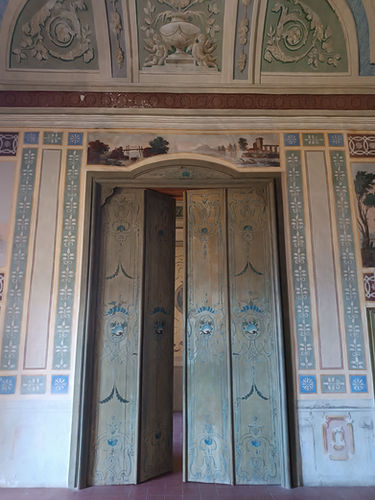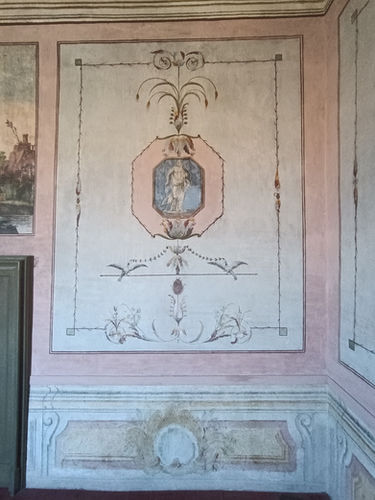
Living rooms
AUDIO GUIDE(choose your language)
Dear visitor, here you have arrived in the living rooms of the Barons of Carini.
This room takes you through the door on your left, into the women's gallery of the Castle Chapel.
As soon as you pass the door, I invite you to initially continue to the right.
You are in the vestibule adjacent to the women's gallery.
The room is decorated with frescoes using the trompe-l'œil technique.
The fresco painting which reproduces simple floral motifs is present above all to replace the absence of architectural reliefs.
Of particular importance is the La Grua coat of arms, placed as the central rose window of the vault.
I invite you now, to cross the women's gallery, enjoy the beauty of the decoration of the Chapel for a few more moments, and then continue towards the main living room of the Castle.
The room, intended as a study and antechamber to the alcove, is decorated with motifs that date back to typical 18th century frescoes with views of landscapes with ancient ruins. In some places, frescoes dating back to the previous period can be glimpsed.
These modernization interventions were carried out at the behest of Don Vincenzo La Grua, Third Prince of Carini around the first half of the 18th century.
The room has a false fireplace in red marble, and on the barrel vault, you can admire a valuable fresco depicting "Ulysses meeting Penelope, in the company of the dog Argo"; scene inspired by the verses contained in Homer's Odyssey in book XVII.
From this room, through a beautiful eighteenth-century portal, you enter the Alcove, where the bed of the Barons of the Castle was located. The room has a square shape with a royal vault, and the walls, as well as the vault, are decorated with floral paintings typical of the Grotesque frescoes of the time.
This and many other rooms, at the time of the war of nineteen fifteen and nineteen forty, were used as barracks and had been whitewashed and defaced. Thanks to the restoration work, it was possible to recover this incredible pictorial heritage.
From this room, through the door to the right of the fireplace, you can continue your visit to the adjacent living rooms.
The rooms you will visit are all entirely frescoed, often showing different and overlapping styles, demonstrating the fact that over the centuries there has been a lot of work carried out in the castle and embellishments.
You are now in the Grotesque room, whose frescoes were probably created around the second half of the 16th century, taking inspiration from a style that was very popular in that period. The grotesques are the result of a real archaeological discovery which took place in 1480, when the rooms of the Domus Aurea, the immense palace of Nero at the time half-buried by debris, were explored and meticulously surveyed: precisely the caves from which the name derives of style.
Grotesques are a typically Renaissance style of wall decoration inspired by Pompeian paintings in the third and fourth styles, which however also enjoyed widespread popularity during the Baroque, Rococo, Eclecticism and Art Nouveau periods. Their temporal diffusion is therefore between the end of the 15th and the beginning of the 20th century.
Continue your visit through the door in the center of the wall.
You are in the Pompeiana room.
The archaeological excavations of Pompeii, from the eighteenth century onwards, have contributed not only to deepening the history and culture of Ancient Rome, but have literally launched fashions and artistic trends: neoclassicism, effectively contributing to enriching the history of universal art. In the villas, theaters and large city buildings, the "Pompeian" style and artistic solutions were an important point of reference for artists, decorators, plasterers and sculptors of the time in the second half of the eighteenth century and throughout the nineteenth century. . We find the fashion of Pompeii in the colours, in the decorations with classical figures, even in the architectural solutions of some delightful villas.
In this room, artists and decorators have applied the typically eighteenth-century taste of Pompeian painting. The use of reds, ochres, blacks is a reworking, albeit not of very high quality, of some paintings found in the domus of the Pompeii excavations.
Now approach the Balcony and admire the splendid atrium of the Castle from this point.
I now invite you to continue the journey, through the door on the right of the balcony.
In this room we find the same pictorial style as the study adjacent to the alcove. The style is typical of the 18th century frescoes with views of landscapes with ancient ruins.
But continue your visit, crossing the door in front of the balcony.
You find yourself in a room that clearly highlights, following the restoration carried out, the various periods of construction and expansion of the Castle.
I now invite you to continue your visit, towards the Castle's Festival Hall.






























